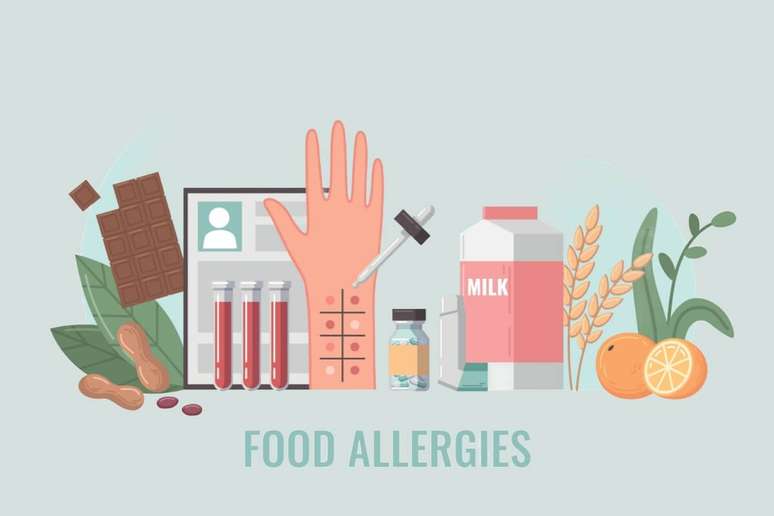Find out the main symptoms and what to do in case of allergic attacks
Food allergy occurs when the immune system responds abnormally to certain foods, even in small amounts, which can cause mild to severe reactions. An example of this was the case of influencer Dominique Brown, who died at the age of 34 after consuming foods she was allergic to during an event at a food company.
“Food allergy is an adverse reaction of the immune system to certain foods. What happens is that certain proteins are identified as harmful by the body, activating an exaggerated immune response that can range from mild to severe and involve multiple body systems “, says nutritionist Dr. Marcella Garcez, director and professor of the Brazilian Association of Nutrology (ABRAN).
The doctor adds that it is essential that people with food allergyas well as family members and healthcare professionals, they are well informed and prepared to deal with possible allergic reactions. Therefore, below, he answers the main questions on the topic. Check!
1. Which foods most commonly cause allergies?
The most common foods that cause food allergies are often referred to as “big eight” allergens, as they are responsible for the majority of food allergic reactions. I am:
- Milkespecially among young children;
- Eggmainly the proteins present in egg white;
- Peanutswhich is among the most serious and potentially fatal food allergies;
- Oilseedssuch as walnuts, almonds and hazelnuts;
- Fish;
- Seafood;
- Soywhich is very common in children, but can be overcome during childhood;
- Grain, which can cause reactions due to a series of proteins, and not just the gluten.
2. What are the symptoms of a food allergy?
Symptoms of a food allergy can vary widely in severity and can affect different parts of the body. They usually appear within a few minutes to a few hours after ingesting the allergenic food. Hives, itching, eczema and angioedema, i.e. swelling of the deeper layers of the skin, may appear on the skin.
Gastrointestinal symptoms include abdominal pain, nausea, vomiting, and diarrhea. As for respiratory symptoms, we can mention nasal congestion, rhinorrhea, sneezing, coughing, wheezing, difficulty breathing and glottis edema, which is a swelling of the throat that can make breathing difficult.
Cardiovascular symptoms, including dizziness, fainting, drop in blood pressure, and palpitations, may also occur. Finally, there is the risk of anaphylaxis, which is a serious and potentially fatal allergic reaction, with symptoms such as swelling of the throat and difficulty breathing, sharp drop in blood pressure, loss of consciousness, rapid and weak pulse, generalized skin rashes and itching, as well as to neurological symptoms such as confusion and anxiety.
3. What to do when you notice food allergy symptoms?
When you notice symptoms of a food allergy, it is important to act quickly and appropriately to avoid complications. First, it is important to recognize and identify the severity of the symptoms and then administer the appropriate medication.
For mild to moderate symptoms, antihistamines are indicated. TO symptoms or signs of anaphylaxis, the use of an epinephrine auto-injector is recommended. Even in the event of severe symptoms or after administration of adrenaline, it is essential to call the emergency services immediately.
Until medical help arrives, position the person correctly to facilitate breathing, in a sitting, semi-sitting position or lying on their side if they are unconscious, and monitor them constantly. If symptoms do not improve within 5 to 15 minutes of the first dose of epinephrine and medical help has not yet arrived, give a second dose of the drug. And even if the person seems to be improving, it is still essential to be evaluated in hospital. Biphasic reactions may occur, with symptoms returning after a period of improvement.

4. What tests can be done to identify food allergies?
If you suspect a food allergy, the most important thing is to consult a doctor. specialist doctor in allergology/immunology. The specialist may request:
- Detailed medical history;
- Food diary to identify foods that may be related to symptoms;
- Blood tests;
- Oral provocation test, in which the consumption of the suspected food is carried out in increasing doses under strict medical supervision;
- Elimination diet, in which suspect foods are completely avoided for a set period;
- Point-to-point testing, in which quantities of food are applied to the skin;
- Food allergen component testing, which tests for specific components of food proteins that can cause allergic reactions.
5. How to prevent food allergies?
Preventing food allergies involves a combination of strategies, especially for people who already know they are allergic to certain foods. It’s important to avoid allergenic foods by reading labels, asking about ingredients when eating out, and using safe products.
Be careful in the kitchen due to cross contamination. The ideal is to use separate kitchen utensils. Additionally, it is crucial to train friends and family to recognize and respond to an allergic reaction by making sure everyone knows how to use an epinephrine auto-injector.
Always carry an epinephrine auto-injector, antihistamines and any other prescribed medications, and have a clear action plan for allergy emergencies. It is also interesting to wear a bracelet or necklace that tells you about your food allergy and how it unfolds requests Regular check-ups with an allergist to monitor the condition, adjust the management plan and update treatments.
It is also worth highlighting that, in childhood, a introduction of food Pediatrician guidance and exclusive breastfeeding for up to six months are strategies that can help prevent the development of food allergies.
By Maria Claudia Amoroso
Source: Terra
Ben Stock is a lifestyle journalist and author at Gossipify. He writes about topics such as health, wellness, travel, food and home decor. He provides practical advice and inspiration to improve well-being, keeps readers up to date with latest lifestyle news and trends, known for his engaging writing style, in-depth analysis and unique perspectives.








